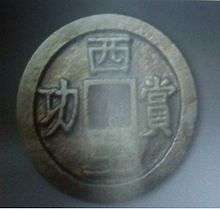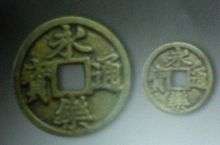Ming dynasty coinage





Chinese coinage in the Ming dynasty saw the production of many types of coins. During the Ming dynasty of China, the national economy was developed and its techniques of producing coinage were advanced. One early period example is the Bronze 1 cash. Obverse: "HUNG-WU T'UNG-PAO". Reverse: blank. Average (18 specimens) 23.8 mm, 3.50 grams (the weight vary considerable and we have records of specimens from 2.2 to 4.1 grams).
Background
In 1368, the Yuan dynasty fell and Zhu Yuanzhang came to the throne. He made Yingtian (today's Nanjing, in Jiangsu province) the capital and named the reigning dynasty as Ming. In 1421, Zhu Di moved to Beijing and made it the capital. In 1644, Li Zicheng captured Beijing and Ming died out. Altogether, the Ming furnished China with sixteen emperors with a combined duration of 277 years.
Coinage in the early Ming era
Usually, Chinese money is a round coin with a square hole in the center. On the obverse side, there are usually words. On the reverse side, there are words or graphic patterns. It is also possible there is nothing on the reverse side. In the early period of the Ming dynasty, though, there were many different types of coin. Examples include:
- Da Zhong Tong Bao (Chinese: 大中通宝)
- Hong Wu Tong Bao" (Chinese: 洪武通宝)
- Hong Xi Tong Bao" (Chinese: 洪熙通宝)
- Yong Le Tong Bao" (Chinese: 永乐通宝)
- Zheng De Tong Bao" (Chinese: 正德通宝)
- Hong Zhi Tong Bao" (Chinese: 弘治通宝)
- Yong Le Tong Bao" (Chinese: 永乐通宝)
- Jia Jing Tong Bao" (Chinese: 嘉靖通宝)
- Jia Jing An Bao" (Chinese: 嘉靖安宝)
- Wan Li Nian Zao" (Chinese: 万历年造)
- Wan Li Tong Bao" (Chinese: 万历通宝)
- Tian Qi Tong Bao" (Chinese: 天启通宝)
- Chong Zhen Tong Bao" (Chinese: 崇祯通宝)
Most of the coinage names are derived from the titles of the reigns during which they were produced. For example,"Hong Wu Tong Bao" was produced during the Hongwu years (1368—1398).
Words on the coinage
During the transitional period between Ming and Qing, various rebels and pretenders made their own money with different Chinese characters on it. Usually, there are four words on each side of a coin.
| Chinese characters on the Coinage | Producer |
|---|---|
| Yong Chang Tong Bao (Chinese: 永昌通宝)[1] | Li Zicheng |
| Da Shun Tong Bao (Chinese: 大顺通宝)[2] | Zhang Xianzhong |
| Xi Wang Shang Gong (Chinese: 西王赏功)[3] | Zhang Xianzhong |
| Xing Chao Tong Bao (Chinese: 兴朝通宝)[4] | Sun Kewang[5] |
| Da Ming Tong Bao (Chinese: 大明通宝)[6] | Nan Ming |
| Hong Guang Tong Bao (Chinese: 弘光通宝)[7] | Nan Ming |
| Long Wu Tong Bao (Chinese: 隆武通宝)[8] | Nan Ming |
| Yong Li Tong Bao (Chinese: 永历通宝)[9] | Nan Ming |
| Zhao Wu Tong Wu (Chinese: 昭武通宝)[10] | Wu Sangui |
| Li Yong Tong Bao (Chinese: 利用通宝)[11] | Wu Sangui |
| Hong Hua Tong Bao (Chinese: 洪化通宝)[12] | [Wu Shifan] |
| Yu Min Tong Bao (Chinese: 裕民通宝)[13] | Geng Jingzhong |
Hong Xi Tong Bao
"Hong Xi Tong Bao" was produced in 1425, during Hongxi years, when Zhu Gaochi was the emperor of Ming. It is very rare. Until now, only two of them have ever turned up in public. Still, one has been lost and the other now is in the Chinese History Museum. "Hong Xi Tong Bao" has been regard as a piece of national historical relics in China.
Yong Le Tong Bao
"Yong Le Tong Bao" was produced by Zhu Di, one of the emperors in Ming. In the very beginning of Ming, paper money was widely used. After Zhu Di came to the throne, he carried out a series of reforms covering all fields, including politics, economy, culture, military and diplomacy. Out of the diplomatic and foreign trade needs, he produced"Yong Le Bao Tong" in 1408.
Chong Zhen Tong Bao
"Chong Zhen Tong Bao" was the coin produced by the last Ming Emperor. It was issued in various denominations. On the reverse side, there are numerous characters and dots, whose meaning is still not clear. At the time, there were mints run by the Board of Revenue in Nanjing and Beijing.[14]
Xing Chao Tong Bao
"Xing Chao Tong Bao" was produced by Sun Kewang, in 1649, Shunzhi six years, when he became the Dongping King. At that time, Sun produced a large number of "Xing Chao Tong Bao" and it had its distinct features with a profond influence. The style of the Chinese characters on the coinage was plain. Most of the coinage was made of copper. Though the work was a little rough, but it was given full weight. This style was reflected in the later "Li Yong Bao Tong", "Zhao Wu Bao Tong" produced by Wu SanGui and "Hong Hua Bao Tong" produced by Wu shifan.
Xi Wang Shang Gong and Zhang Xianzhong
Zhang Xianzhong was a famous leader of the peasant rebel army in the late Ming dynasty.[15] In 1630, he joined the peasant rebel army. In 1643, he was entitled "Da Xing Wang". In 1644, he dominated Sichuan and became the king of Chengdu, named the reigning dynasty as "Da Xi" and his reign as "Da Shun". Zhang produced his money "Da Shun Tong Bao" as the official currency. In order to honor those who made contribution to Da Xi dynasty, he produced another money called "Xi Wang Shang Gong" as an award to them. There are four kinds of "Xi Wang Shang Gong", which are made of gold, gilding, silver and copper. At that time, the peasant rebel army won people's great admiration and support. "Da Shun Tong Bao" was often sewn onto clothing as a sort of celebration to the peasant rebel army. Since it was very difficult to get "Xi Wang Shang Gong", it was very rare and precious. It was nearly an impossible condition that ordinary people could get it. As a result, there are very few remaining today.
References
- ↑ http://www.mycollect.net/trade/show-1994360-2.html
- ↑ http://www.soniu.net/view-5805921859.html
- ↑ http://www.mycollect.net/trade/show-2318690-2.html
- ↑ http://finance.sina.com.cn/money/collection/qbyp/20100803/16408414992.shtml
- ↑ http://www.sxsdq.cn/dqzlk/sxsz/rwzsc/200903/t20090317_4794.htm
- ↑ http://tag.cangdian.com/html/1116/Tag_1116_wz.html
- ↑ http://www.gucn.com/Service_CurioStall_Show.asp?ID=3168626
- ↑ http://www.gucn.com/Service_CurioAuction_Show.asp?ID=2892383
- ↑ http://news.163.com/09/0517/08/59GJAMTD0001124J.html
- ↑ http://www.mycollect.net/trade/show-1902337-2.html
- ↑ http://www.mycollect.net/trade/show-2291362-2.html
- ↑ http://www.mycollect.net/trade/show-2546755-2.html
- ↑ http://www.mycollect.net/trade/show-250212-2.html
- ↑ Hartill, David (2005). Cast Chinese Coins. Trafford. pp. 256–61.
- ↑ http://military.china.com/zh_cn/critical3/27/20070112/13874108.html
| ||||||||||||||||||||||||||||||